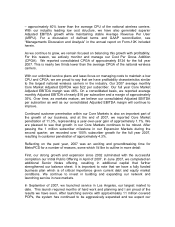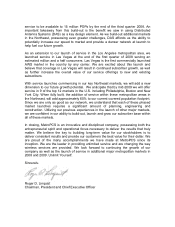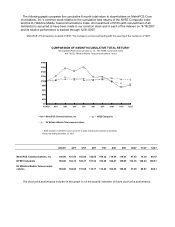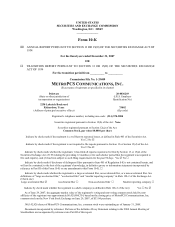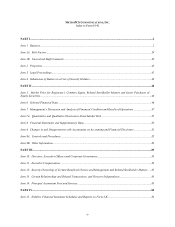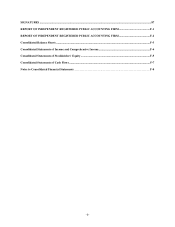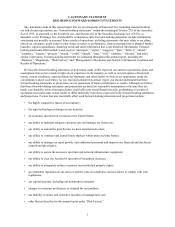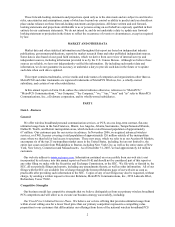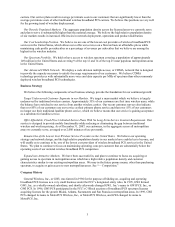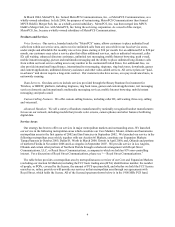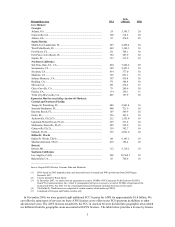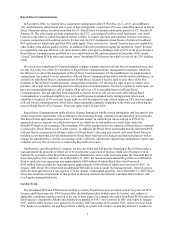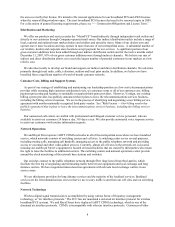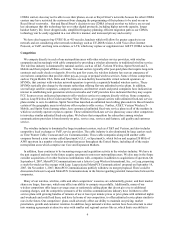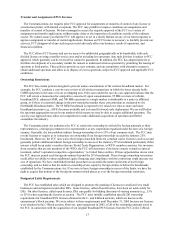Metro PCS 2007 Annual Report Download - page 14
Download and view the complete annual report
Please find page 14 of the 2007 Metro PCS annual report below. You can navigate through the pages in the report by either clicking on the pages listed below, or by using the keyword search tool below to find specific information within the annual report.3
carriers. Our service plans result in average per minute costs to our customers that are significantly lower than the
average per minute costs of other traditional wireless broadband PCS carriers. We believe this positions us very well
for the growing trend of wireline displacement.
Our Densely Populated Markets. The aggregate population density across the licensed areas we currently serve
and plan to serve is substantially higher than the national average. We believe the high relative population density
of our markets results in increased efficiencies in network deployment, operations and product distribution.
Our Cost Leadership Position. We believe we are one of the lowest cost providers of wireless broadband PCS
services in the United States, which allows us to offer our services on a flat-rate basis at affordable prices while
maintaining cash profits per subscriber as a percentage of revenues per subscriber that we believe are among the
highest in the wireless industry.
Our Spectrum Portfolio. We hold or have access to wireless spectrum covering a population of approximately
149 million in the United States and covering 9 of the top 12 and 14 of the top 25 most populous metropolitan areas
in the United States.
Our Advanced CDMA Network. We deploy a code division multiple access, or CDMA, network that is designed
to provide the capacity necessary to satisfy the usage requirements of our customers. We believe CDMA
technology provides us with substantially more voice and data capacity per MHz of spectrum than other commonly
deployed wireless broadband PCS technologies.
Business Strategy
We believe the following components of our business strategy provide the foundation for our continued growth:
Target Underserved Customer Segments in our Markets. We target a mass market which we believe is largely
underserved by traditional wireless carriers. Approximately 55% of our customers are first time wireless users, while
the balance have switched to our service from another wireless carrier. Our recent customer surveys also indicate
that over 85% of our customers use our service as their primary phone service and that over 55% of our customers
no longer use their traditional landline phone service, which we believe means that our service is gaining acceptance
as a substitute for landline service.
Offer Affordable, Fixed Price Unlimited Service Plans With No Long-Term Service Contract Requirement. Our
service is designed to provide mobile functionality while reducing or eliminating the gap between traditional
wireless and wireline pricing. As of December 31, 2007, our customers, in the aggregate across all metropolitan
areas we currently serve, averaged over 2,000 minutes of use per month.
Remain One of the Lowest Cost Wireless Service Providers in the United States. We believe our operating
strategy and network design, and the high relative population density in our markets have enabled us to become, and
will enable us to continue to be, one of the lowest cost providers of wireless broadband PCS services in the United
States. We plan to continue to focus on maintaining operating costs per customer that are substantially below the
operating costs of our national wireless broadband PCS competitors.
Expand into Attractive Markets. We have been successful in, and plan to continue to focus on, acquiring or
gaining access to spectrum in metropolitan areas which have high relative population density and customer
characteristics similar to our existing metropolitan areas. We may in the future pursue means, other than purchasing
spectrum, to acquire or gain access to new metropolitan areas. See “— Competition.”
Company History
General Wireless, Inc., or GWI, was formed in 1994 for the purpose of bidding on, acquiring and operating
broadband PCS licenses as a very small business under the FCC’ s designated entity rules. In 1995, GWI formed
GW1, Inc. as a wholly-owned subsidiary, and shortly afterwards changed GW1, Inc.’ s name to GWI PCS, Inc., or
GWI PCS. In 1996, GWI PCS participated in the FCC’ s C-Block auctions of broadband PCS spectrum licenses
acquiring licenses for the greater Miami, Atlanta, Sacramento and San Francisco metropolitan areas. In 1999, GWI
PCS changed its name to MetroPCS Wireless, Inc., or MetroPCS Wireless, and GWI changed its name to
MetroPCS, Inc.


